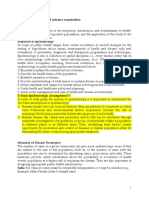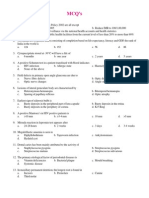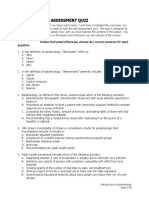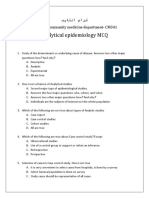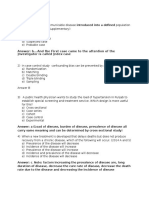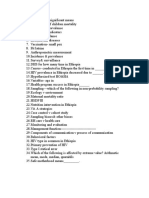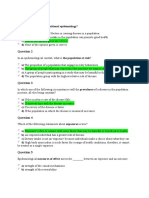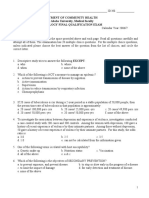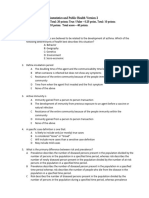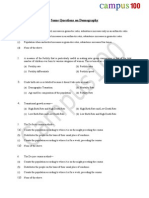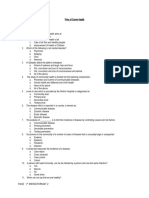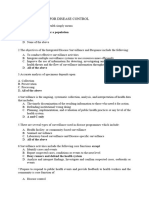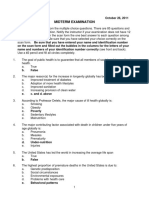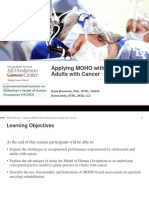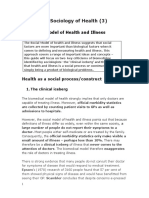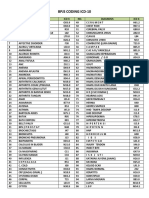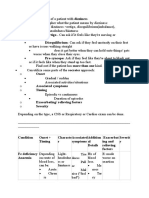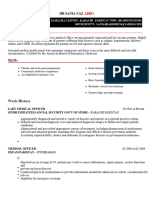100%(2)100% found this document useful (2 votes)
619 viewsMPH Entrance Exam
MPH Entrance Exam
Uploaded by
million assefaThe document provides a sample exam for entrance into a joint MPH program between Addis Continental Institute of Public Health and University of Gondar. It consists of 34 multiple choice questions testing knowledge of key public health concepts. The questions cover topics like epidemiology, demography, communicable and non-communicable diseases, nutrition, health systems, and research methods. The exam aims to evaluate applicants' understanding of important public health issues in Ethiopia and globally.
Copyright:
© All Rights Reserved
Available Formats
Download as DOC, PDF, TXT or read online from Scribd
MPH Entrance Exam
MPH Entrance Exam
Uploaded by
million assefa100%(2)100% found this document useful (2 votes)
619 views5 pagesThe document provides a sample exam for entrance into a joint MPH program between Addis Continental Institute of Public Health and University of Gondar. It consists of 34 multiple choice questions testing knowledge of key public health concepts. The questions cover topics like epidemiology, demography, communicable and non-communicable diseases, nutrition, health systems, and research methods. The exam aims to evaluate applicants' understanding of important public health issues in Ethiopia and globally.
Original Title
MPH Entrance Exam (2)
Copyright
© © All Rights Reserved
Available Formats
DOC, PDF, TXT or read online from Scribd
Share this document
Did you find this document useful?
Is this content inappropriate?
The document provides a sample exam for entrance into a joint MPH program between Addis Continental Institute of Public Health and University of Gondar. It consists of 34 multiple choice questions testing knowledge of key public health concepts. The questions cover topics like epidemiology, demography, communicable and non-communicable diseases, nutrition, health systems, and research methods. The exam aims to evaluate applicants' understanding of important public health issues in Ethiopia and globally.
Copyright:
© All Rights Reserved
Available Formats
Download as DOC, PDF, TXT or read online from Scribd
Download as doc, pdf, or txt
100%(2)100% found this document useful (2 votes)
619 views5 pagesMPH Entrance Exam
MPH Entrance Exam
Uploaded by
million assefaThe document provides a sample exam for entrance into a joint MPH program between Addis Continental Institute of Public Health and University of Gondar. It consists of 34 multiple choice questions testing knowledge of key public health concepts. The questions cover topics like epidemiology, demography, communicable and non-communicable diseases, nutrition, health systems, and research methods. The exam aims to evaluate applicants' understanding of important public health issues in Ethiopia and globally.
Copyright:
© All Rights Reserved
Available Formats
Download as DOC, PDF, TXT or read online from Scribd
Download as doc, pdf, or txt
You are on page 1of 5
JOINT MPH PROGRAM
Addis Continental Institute of Public Health
AND
University of Gondar
Entrance examination for post graduate program
Instruction: choice the best answer
1. What does null hypothesis mean
a. There no difference
b. There is difference
c. None
2. The first census in Ethiopia was done in______________
a. 1996
b. 1984
c. 1975
d. 1998
3. The point prevalence of HIV in Ethiopia is ____________
a. 2.1
b. 4.6
c. .28
d. None
4. TT vaccination of a pregnant mother is mainly for the health of _______________
a. For mother
b. New born
c. For both
d. none
5. Maternal mortality of Ethiopia is closed to _____________
a. 200
b. 300
c. 800
d. 1200
6. The life expectancy at birth of Ethiopia is close to _______________
a. 30
b. 40
c. 50
d. none
7. What does error type one mean
8. Which of the following is statically significant at error type one of 0.05
a. 0.09
b. 0.08
c. 0.01
d. 0.06
9. Which one of the following disease is on eradication in the world
a. Polio
b. Measles
c. Tetanus
d. None
10. Which of the following disease is eradicated from Ethiopia
a. Polio
b. Leprosy
c. Measles
d. Malaria
e. none
11. Good outcome indicator of TB control program
a. Case detection rate
b. Cure rate
c. Defaulter rate
d. none
12. The most successful public health activity in the twenty first century
a. Vaccination
b. Environmental sanitation
c. Family planning
d. all
13. Which of the following central tendency measure is most affected by both extreme values
a. Arithmetic mean
b. Range
c. Mode
d. median
14. Age in years is _______________ type of variable
a. Ratio
b. Interval
c. Ordinal
d. nominal
15. The most appropriate type of graph to present categorical data is
a. Histogram
b. Bar graph
c. Line graph
d. Spot map
16. What is the difference between surveillance and survey
17. How many diseases are targeted by EPI in 1990
a. Six
b. Seven
c. Eight
d. Five
18. Which of the following is sign of chronic malnutrition
a. Wasting
b. Stunting
c. KW
d. none
19. Target of primary prevention includes all except
a. Individual
b. High risk group
c. Population
d. Diseased person
20. Which of the following is not the advantage of public health
a. Treatment of all people
b. Health promotion
c. Health education
d. None
21. The health sector development program (HSDP)currently Ethiopia implementing
a. 1st
b. 2nd
c. 3rd
d. 4th
22. Sample variance is unbiased estimate of population mean the word unbiased mean
23. Which of the following is not public health problem of Ethiopia
a. Malaria
b. Motor accident
c. HIV
d. none
24. Routine health data collection is called
a. Facility survey
b. Surveillance
c. Research
d. none
25. Safe mother hood is primarily designed
a. Designed to decrease maternal mortality due to child birth
b. Designed to prevent abortion
c. Designed to prevent maternal infection
d. None
26. The most prevalent child killer in Ethiopia
a. Malnutrition
b. Malaria
c. Pneumonia
d. None
27. Which of the following shows Global response for health and social problems
a. Global fund for TB and HIV
b. Millennium development goal
c. Rollback malaria
d. none
28. In the Prevention of HIV ‘ABC’ b stands for
a. Abstinences
b. Be faithful
c. Use condom
29. Trend of HIV in Ethiopia is
a. Increasing
b. Decreasing
c. Not known
d. none
30. Relative measure of variables
a. Standard deviation
b. Variance
c. Coefficient of variation
d. None
31. Which of the following is not major cause of hospital death in Ethiopia
a. TB
b. HIV
c. Diabetes
d. None
32. The most prevalent type of HIV in Ethiopia
a. Type one
b. Type two
c. Type three
d. None
33. Which one of the following is not included in case definition
a. Time
b. Person
c. Place
d. Hypostasized risk factor
34. Which of the following is not probability sampling
a. Cluster sampling
b. judgmental sampling
c. Random sampling
d. none
You might also like
- 130 TOP Epidemiology Multiple Choice Questions and Answers - All Medical Questions and AnswersDocument12 pages130 TOP Epidemiology Multiple Choice Questions and Answers - All Medical Questions and AnswersFaiq Syukri Bin Saparudin83% (173)
- 100 Multiple-Choice Questions (MCQS) For Biostatistics - Clinical CornerDocument16 pages100 Multiple-Choice Questions (MCQS) For Biostatistics - Clinical Cornerilerioluwaibitoye100% (1)
- Epidemiology MCQs For Entrance Examination of Master of Public HealthDocument33 pagesEpidemiology MCQs For Entrance Examination of Master of Public HealthBijay kumar kushwaha67% (12)
- MPH Entrance Examination With AnswersDocument42 pagesMPH Entrance Examination With Answersahmedhaji_sadik93% (90)
- Public Health MCQDocument2 pagesPublic Health MCQYemi-jonathan Julie O64% (11)
- Self-Assessment Quiz: Introduction To Epidemiology Page 1-85Document75 pagesSelf-Assessment Quiz: Introduction To Epidemiology Page 1-85Coy Nuñez100% (8)
- Answer of Exercises-Measures of Disease FrequencyDocument7 pagesAnswer of Exercises-Measures of Disease Frequencysanjivdas100% (4)
- 100 MCQs For Master of Public HealthDocument12 pages100 MCQs For Master of Public HealthMuhammad Ali100% (1)
- Descriptive studies MCQs فراسDocument6 pagesDescriptive studies MCQs فراسHisokagen100% (4)
- Public HealthDocument29 pagesPublic HealthKirubel Kassahun100% (2)
- Book - Community Medicine MCQSDocument52 pagesBook - Community Medicine MCQSMuhammad Javed Gaba100% (3)
- Epidemiology - Exercises. Gaetano MarroneDocument4 pagesEpidemiology - Exercises. Gaetano Marronemillion assefaNo ratings yet
- Public Health Policy and Management MCQsDocument6 pagesPublic Health Policy and Management MCQsJhon WickNo ratings yet
- Cardiac Tamponade: Mrs. D.Melba Sahaya Sweety.D M.SC Nursing GimsarDocument23 pagesCardiac Tamponade: Mrs. D.Melba Sahaya Sweety.D M.SC Nursing GimsarD. Melba S.S ChinnaNo ratings yet
- TEST YOURSELF: Multiple Choice 1 QuestionsDocument5 pagesTEST YOURSELF: Multiple Choice 1 Questionsanaphysioforyou50% (2)
- Questions For Community Medicine MD 4Document11 pagesQuestions For Community Medicine MD 4Bindashboy0100% (2)
- Epidemiology MCQDocument122 pagesEpidemiology MCQሌናፍ ኡሉም50% (4)
- 2006 MCQ ExamsDocument18 pages2006 MCQ ExamsTehreem Khan100% (1)
- 2010 MPH Entrance ExaminationDocument3 pages2010 MPH Entrance ExaminationMeseret Raga100% (1)
- Enterance ExamDocument2 pagesEnterance Examahmedhaji_sadikNo ratings yet
- H-Public HealthDocument12 pagesH-Public Healthخالد المهدي خالد شاهين100% (2)
- Eden Env. Epid Exam-2Document9 pagesEden Env. Epid Exam-2kalasa royd100% (5)
- Final McqsDocument11 pagesFinal McqsShaban Yasser100% (1)
- 110 TOP SOCIAL and PREVENTIVE Multiple Choice Questions and Answers PDF 2019Document24 pages110 TOP SOCIAL and PREVENTIVE Multiple Choice Questions and Answers PDF 2019SunilKumar D100% (1)
- Examinations Council of Health Sciences/Unza: Final Examinations For Diploma in Environmental Sciences FORDocument12 pagesExaminations Council of Health Sciences/Unza: Final Examinations For Diploma in Environmental Sciences FORkalasa royd100% (3)
- Analytical epidemiology MCQs فراسDocument12 pagesAnalytical epidemiology MCQs فراسHisokagen100% (2)
- Model Paper - 3: Smoking YesDocument7 pagesModel Paper - 3: Smoking YesDr-Sanjay Singhania100% (3)
- Answer: B... and The First Case Came To The Attention of The Investigator Is Called Index CaseDocument6 pagesAnswer: B... and The First Case Came To The Attention of The Investigator Is Called Index Casesmbawasaini0% (1)
- Quiz 1Document17 pagesQuiz 1Mao Gallardo100% (2)
- Epidemmiology MCQs With Key 2Document10 pagesEpidemmiology MCQs With Key 2Asaad AltayyanNo ratings yet
- Community Medicine MCQs PDFDocument355 pagesCommunity Medicine MCQs PDFSangeeta GuptaNo ratings yet
- MPH Entrance Examination With AnswersDocument41 pagesMPH Entrance Examination With Answersmillion assefaNo ratings yet
- Epidemiological InterpretationDocument9 pagesEpidemiological InterpretationKrishnaveni MurugeshNo ratings yet
- Epidemiology MCQsDocument13 pagesEpidemiology MCQsparackalphilipNo ratings yet
- Eep June 2018 With AnsDocument13 pagesEep June 2018 With Anskalasa royd100% (3)
- Multiple Choice QuestionsDocument7 pagesMultiple Choice QuestionsTaran JOt100% (2)
- PREVENTIVE FinalDocument86 pagesPREVENTIVE FinalAndrassy Twinkle AlineaNo ratings yet
- MPH TestDocument47 pagesMPH Testahmedhaji_sadik50% (2)
- Epidemiology MCQDocument9 pagesEpidemiology MCQPREM KUMAR100% (3)
- MPH Entrance Exam For 2007Document3 pagesMPH Entrance Exam For 2007ahmedhaji_sadik100% (8)
- Epidemiology MCQ 2Document4 pagesEpidemiology MCQ 2Martinc2383% (12)
- Preventive and Social Medicine Public Health PDFDocument10 pagesPreventive and Social Medicine Public Health PDFRaj Subedi100% (2)
- 208 - Quiz 1 and 2 Epid (2017)Document9 pages208 - Quiz 1 and 2 Epid (2017)Bejo Makmur100% (8)
- Community Medicine MCQDocument2 pagesCommunity Medicine MCQrajucha100% (3)
- Epidemiology, Qustion, Final Qualifying Exam, 240907Document3 pagesEpidemiology, Qustion, Final Qualifying Exam, 240907tesfaye gelan100% (1)
- DocxDocument12 pagesDocxFarah Farah50% (2)
- Epidemiology NotesDocument4 pagesEpidemiology Notesapi-237394422100% (1)
- Community Medicine BCQs (Primary Health Care)Document5 pagesCommunity Medicine BCQs (Primary Health Care)Sajid AliNo ratings yet
- Introduction To Epidemiology and Public Health - AnswersDocument8 pagesIntroduction To Epidemiology and Public Health - Answersjackwisher hasting100% (2)
- 2 - Epidemiology-MCQs-for-entrance-examination-of-Master-of-Public-HealthDocument2 pages2 - Epidemiology-MCQs-for-entrance-examination-of-Master-of-Public-HealthShaira Rae Billena0% (1)
- MD3150E Epidemiology Biostatistics 6 PDFDocument11 pagesMD3150E Epidemiology Biostatistics 6 PDFAhmad Rajoub100% (2)
- MPH ExamDocument2 pagesMPH Exammillion assefaNo ratings yet
- Public Health COC ExamDocument19 pagesPublic Health COC ExamTut Kong Ruach100% (3)
- Some Questions On DemographyDocument2 pagesSome Questions On Demographykumarmjha9112100% (1)
- Princ of Com HealthDocument3 pagesPrinc of Com Healthramadhani mangapiNo ratings yet
- Final Exam - Best, Sample ExamDocument8 pagesFinal Exam - Best, Sample ExamSolomonNo ratings yet
- Emerging Infectious DiseasesDocument24 pagesEmerging Infectious Diseasesminahilsafdar14No ratings yet
- Final Q&A Disease Control 2015 Licensure-1Document17 pagesFinal Q&A Disease Control 2015 Licensure-1fataoabudu93No ratings yet
- Final Key 12-2010 PDFDocument14 pagesFinal Key 12-2010 PDFAbubakar AbdhooNo ratings yet
- Community MCQDocument5 pagesCommunity MCQShafaque IrfanNo ratings yet
- Midterm Key 2011 PDFDocument12 pagesMidterm Key 2011 PDFAbubakar AbdhooNo ratings yet
- PHN End 1ST Year Exam Jul 09Document6 pagesPHN End 1ST Year Exam Jul 09chobeledorisNo ratings yet
- ASSIGNMENTDocument3 pagesASSIGNMENTmillion assefaNo ratings yet
- ROLE OF THE PRIMARY HEALTH Care in DisasterDocument19 pagesROLE OF THE PRIMARY HEALTH Care in Disastermillion assefaNo ratings yet
- MPH ExamDocument2 pagesMPH Exammillion assefaNo ratings yet
- MPH Entrance Examination With AnswersDocument41 pagesMPH Entrance Examination With Answersmillion assefaNo ratings yet
- Anatomi Nervous System (Stroke) New (Autosaved)Document44 pagesAnatomi Nervous System (Stroke) New (Autosaved)Muhammad Syauqi bin AzmiNo ratings yet
- Bdi - IiDocument4 pagesBdi - IifosterbalaNo ratings yet
- MycoplasmaDocument1 pageMycoplasmadjyqwrstngNo ratings yet
- Week 3 LAS EnglishDocument11 pagesWeek 3 LAS EnglishRowena BartolazoNo ratings yet
- GFDFDFDocument7 pagesGFDFDFRm98No ratings yet
- Kode Diagnosa TindakanDocument18 pagesKode Diagnosa Tindakanahmad.hbb4hNo ratings yet
- Literature Review On Oxygen TherapyDocument6 pagesLiterature Review On Oxygen Therapyjzneaqwgf100% (1)
- Neonatal HypotoniaDocument8 pagesNeonatal Hypotoniazulfiqar aliNo ratings yet
- Brood TerrorsDocument3 pagesBrood Terrorsgmfr4311No ratings yet
- HiMedia CatalogueDocument1,195 pagesHiMedia CatalogueAbhishek SharmaNo ratings yet
- HX and PX Obstetrics and GynecologyDocument21 pagesHX and PX Obstetrics and GynecologyTadesse MuhammedNo ratings yet
- Oral Surgery MCQDocument35 pagesOral Surgery MCQوليد خالدNo ratings yet
- Applying Moho With Adolescents & Adults With Cancer: Brent Braveman, PHD., Otr/L, Faota Donna Kelly, Otr/L, M.Ed, CLTDocument20 pagesApplying Moho With Adolescents & Adults With Cancer: Brent Braveman, PHD., Otr/L, Faota Donna Kelly, Otr/L, M.Ed, CLTZahe'sNo ratings yet
- ESSENTIAL OIL PROFILES Simple BookDocument24 pagesESSENTIAL OIL PROFILES Simple BookCristinaNo ratings yet
- Sabino Rebagay Memorial High SchoolDocument6 pagesSabino Rebagay Memorial High SchoolRina RomanoNo ratings yet
- Ampicillin Sodium - Sulbactam Sodium Drug StudyDocument1 pageAmpicillin Sodium - Sulbactam Sodium Drug StudyMelissa Marie Custodio100% (3)
- Health As A Social ConstructDocument7 pagesHealth As A Social ConstructCiara MannionNo ratings yet
- Drugs For Disorders of The Respiratory SystemDocument23 pagesDrugs For Disorders of The Respiratory SystemkwennybiangNo ratings yet
- Diagnosis: Acute GastroenteritisDocument1 pageDiagnosis: Acute GastroenteritisSakshi RanabhatNo ratings yet
- BPJS Coding IcdDocument4 pagesBPJS Coding IcdDewi Agustina100% (1)
- Acacia Senegal: Herbal Plants (Halamang Gamot)Document24 pagesAcacia Senegal: Herbal Plants (Halamang Gamot)SORENI SORENI100% (1)
- CholecystitisDocument4 pagesCholecystitislican abellanosaNo ratings yet
- Pengkajian Pasien GeriatriDocument24 pagesPengkajian Pasien GeriatriLoudry ElfaNo ratings yet
- A Case Study Of: Hypertension Emergency, Hypertensive Cardiovascular DiseaseDocument23 pagesA Case Study Of: Hypertension Emergency, Hypertensive Cardiovascular DiseaseKristine AlejandroNo ratings yet
- Dizziness HXDocument4 pagesDizziness HXbadmanNo ratings yet
- Drug Study Ready TramadolDocument1 pageDrug Study Ready TramadolCezanne CruzNo ratings yet
- Miasm Dosage SuggestionDocument3 pagesMiasm Dosage SuggestionweraratNo ratings yet
- m3 Act3 Emotional DisabilitiesDocument7 pagesm3 Act3 Emotional Disabilitiesapi-516574894No ratings yet
- DR Sania Naz Abro CV 1Document3 pagesDR Sania Naz Abro CV 1Sania AbroNo ratings yet



